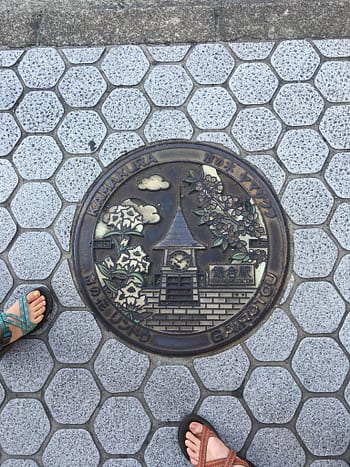“Hiking is a bit like life: The journey only requires you to put one foot in front of the other…again and again and again. And if you allow yourself opportunity to be present throughout the entirety of the trek, you will witness beauty every step of the way, not just at the summit” – Unknown
This summer, Vicki and I celebrated her birthday in Kamakura. For those that haven’t heard me talk about Vicki before, suffice it to say – she. is. amazing. We met as part of the headstart class when we first arrived in Japan. She works for the Girl Scouts and initially hooked me into that job. Vicki loves to travel (we have plans this winter to visit Cambodia), and worked in Morocco with the Peace Corps. She is undoubtedly my best friend here. So, when she said she wanted to go see something new for her birthday, I was all in!
After an evening of wine and pizza and store-bought birthday cake (is it really a birthday if you don’t have cake?), we were up and at ’em early the next morning. By train, the route to Kamakura takes a little over an hour. Once the political capital of Japan, Kamakura joins the ranks of other well-known cities like Kyoto. This city of just over 170,000 people was also the birthplace of Japan’s first military government. Because of its rich history, particularly related to the samurai culture, you can find more than 1,000 religious structures throughout the city. It is most well known for the “Big Buddha” statue. Of course, the city itself has a great vibe – beachy and historic with lots of small shops selling handmade goods.

Hiking in Kamakura
We knew we wanted to hike, so we left the train station and headed straight for the Gion-yama hiking trail. Aptly named, the trail winds through the eastern Gion-yama hills. It is a pretty easy walk, well-marked, and takes about an hour. For those that know me in real life, you know I’m not much of a hiker. But, in the spirit of friendship and adventure, I said yes. So here I stand, at the base of a flight of stone steps, wondering what I’ve gotten myself into.
Luckily, the internet didn’t lie and the hike was pretty manageable (although I should have worn actual shoes instead of Chacos). We crossed some major root systems on trees probably older than I am. One of the other big draws for this adventure was the promise of geocaches. Having geocached in multiple countries, Vicki’s birthday wish was to find one on this hike.
For those, like me, that are unfamiliar with geocaching, the basic gist is to use a website to find small, hidden treasures left by someone else, right under your nose. Take and replace what you find, log it, and do it again. (Ok, I’m sure there’s more to it than that. You can read more here and here). Vicki and I have tried to geocache in Japan before unsuccessfully. So, we had high hopes for today.
Using the geocache website, we found a recently replaced geocache close to the trail’s “scenic point”. The website tells you the most recent find of the geocache, which helps you to know it’s actually there, as well as hints from other finders. After much searching and almost giving up, we found it! I signed the log book (my first geocache), and we started our way down the mountain.
Tradition Meets Present Day
The Gion-yama trail ends at the backside of the Yagumojin-ja shrine. Founded by Minamoto Yoshimitsu, Yagumojin-ja is one of Kamakura’s oldest shrines. Shrines are used in the Shinto religion, and I find them fascinating. I always feel a bit odd entering into the sacred spaces of other religions. Because I’m not a Shintoist, I only know a bit about their religious practices. The Yagoumojin-ja shrine is absolutely beautiful and feels very secluded. We entered from the back, so our introduction to the space was different than had we gone in the front. It was only when we left that we realized how close to the neighborhood we actually were.
Despite having hiked and seen a shrine, it’s still early in the day. We wander through neighborhoods without much of an agenda, half-heartedly searching for food but also seeing what there is to see. We stumble upon the Myohon-ji temple. Built during the early 1200s, it’s one of the oldest Nichiren Buddhist temples in Kamakura. To get to the actual temple, you have to scale the side of the hill. Luckily, there are both stairs and a ramp.
The temple itself is beautiful. The wooden architecture and details in the buildings are amazing, and I find myself wondering how 13th-century people managed such a feat. Beautiful flowers surround the temple grounds. Just to the side of the temple is a cemetery. There are brooms for loved ones to use to clean, as well as water that I assume is used for purification.
Although we didn’t see the Big Buddha this time around, our trip to Kamakura was well worth it! We ended the day in town, trying our hand ordering at a small restaurant with no English on the menu or pictures of the food. (Luckily there was someone there to help us out!). We enjoyed a glass of wine at an outdoor cafe, right next to the Enoden train line. The Enoden train uses old-school train cars, adding to the unique charm of the city.
Kamakura is definitely on our list of return visits. Our adventure was a great introduction to the city, but I know there is so much more to see! Until next time!


























